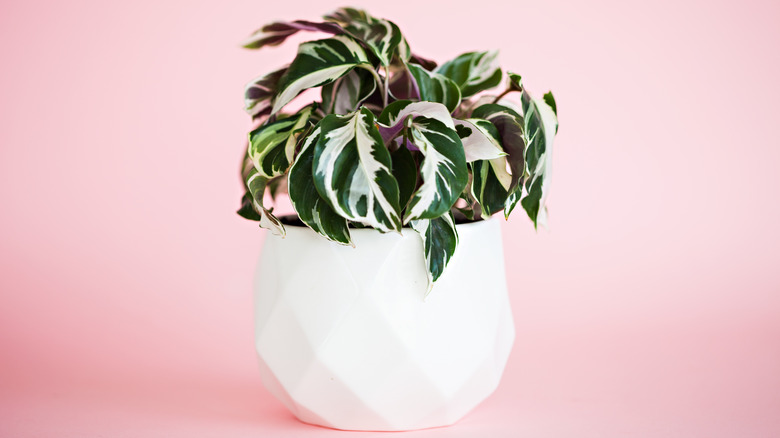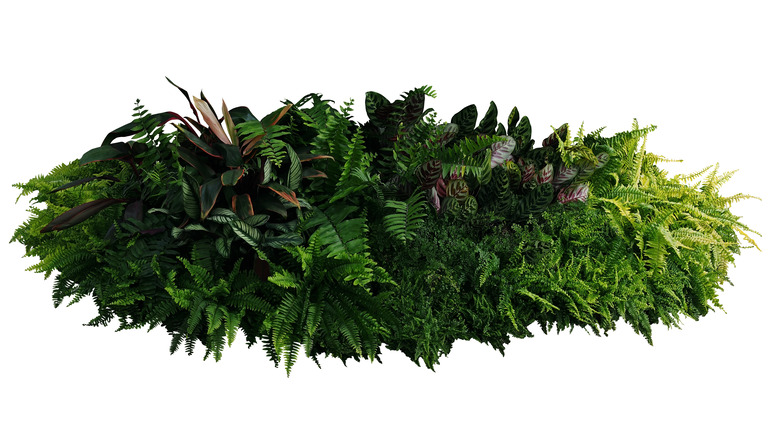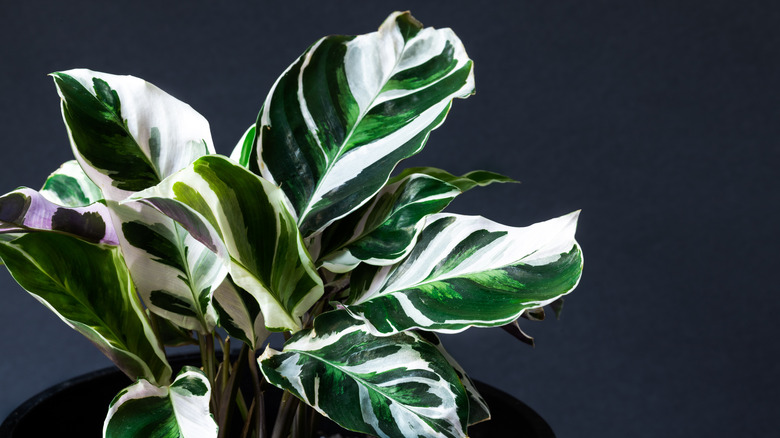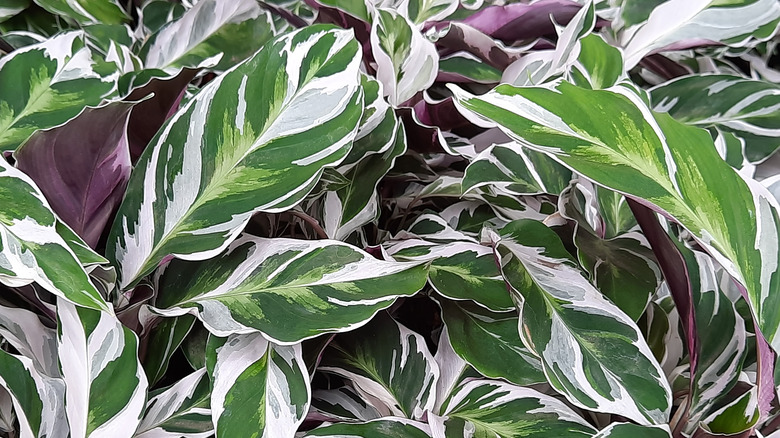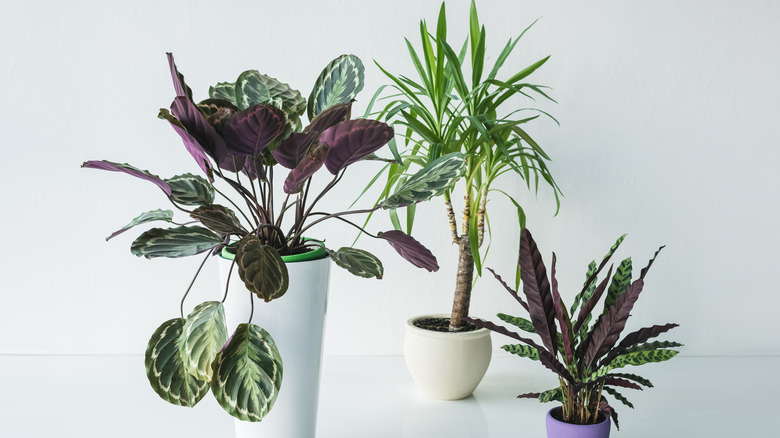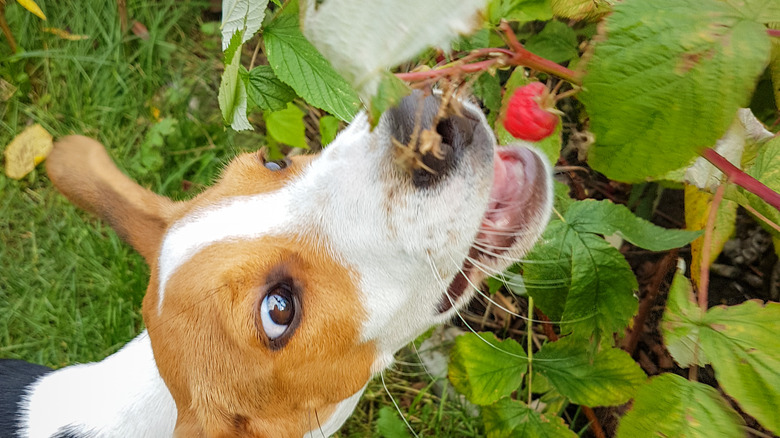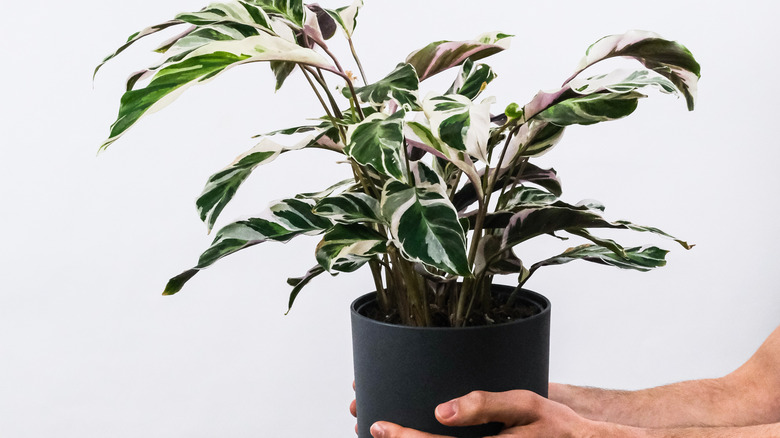Calathea White Fusion: Everything You Should Know Before Planting
Calathea White Fusion is a popular houseplant. With broad, teardrop shaped leaves in deep white and green colors, this plant is ideal for interior decorating as an added indoor accent. The White Fusion, official called Maranta lietzei and also Calathea lietzei, is a tropical plant (via The National Gardening Association) that is also referred to as a prayer plant or a peacock plant depending on who you ask, as listed by Plantophiles. Prayer plants are a name for a type of Marantaceae plant which has leaves that fold up at night, mimicking the human hands folding up in prayer or worship. Not all Calatheas are also Marantaceaes, but only Marantaceaes are considered a "true" prayer plant as described by Gardening Know How. The term peacock plant is used to describe the colorful foliage known for a little extra drama "in the back," as these glossy white and green leaves tend to have a vivid purple color underneath. The folding motion of the plant allows owners to experience the foliage in all areas.
Calatheas tend to be easy to grow plants good for beginners and are suitable for hanging baskets, pots, or terrariums growing happily in partial shade. Plants grow to a height of 6 to 8 inches and leaves are typically no larger than 1 inch. Calathea White Fusion plants are widely available at retailers. Calatheas are also known to help purify air, according to The Little Botanical.
How to use Calathea White Fusion in garden
If used outdoors in a garden setting, Calatheas can be used as a groundcover. Caltheas, including the White Fusion are perennial plants, meaning they grow year round instead of dying off (think evergreen, not a carrot plant). While these plants may flower seasonally, the point is that the leaves will stay green (and white and purple in this case) year round. Frost Garden Centres describes the Calathea as a shade plant as it can grow below dense foliage — as an example, below trees in South American jungles.
While suited for warmer climates, there are some areas of the United States that suit outdoor growing as well. If planting Calatheas outdoors, stick to USDA Zone 10b, which lists a minimum winter temperature between 35 degrees Fahrenheit to 40 degrees Fahrenheit (via Plant Hardiness). Basically, you don't want your prayer plant to freeze. Very hot and dry temperatures, however, will also rob the plant of much-needed moisture.
How to grow Calathea White Fusion
Since the Calathea White Fusion is a tropical plant, it is primarily used in indoor settings in the United States (via The National Gardening Association). Calatheas need optimum care to really make those colors "pop" as described by The Spruce. While these plants can grow below larger tree leaves, they will not thrive in complete shade and still need filtered bright sunlight — too bright and the stripes will fade, too shady and the stripes won't develop at all. While the wrong light won't necessarily cause your plant to perish, it may not show it's true colors either.
Potted Calathea plants need a light and airy soil such as that used for African Violets or a mix using pearlite and bark — just make sure it drains well. Understanding the White Fusion's more tropical beginnings, it's no surprise this plant prefers a humid area with moist soil. It's important that soil does not become wet or waterlogged, as excess undrained water can cause rot and fungus.
How to care for Calathea White Fusion
Caring for your Calathea White Fusion starts with correctly potting your plant is the right soil. After that, care is relatively simple and most beginning gardeners can manage these houseplants — another reason why they are so popular. When it comes to temperature, manage this much like watering with not too much and not too little. You can tell your plant needs water when the top 1 to 2 inches of soil is dry according to Ansel and Ivy. You don't need fancy equipment — simply check with your finger and add moisture accordingly.
A fair weather plant, these tropicals don't like severe weather so avoid locations that can get very hot or very cold even when indoors. Calatheas can also benefit from a liquid houseplant fertilizer applied once a month during growing seasons. Pruning small amounts of dead leaves is ok and will not hurt the plant. Even though indoors, manage growing conditions based on your climate for optimal care.
Varieties of Calathea
White Fusion is not the only variety of Calathea; there are many varieties that while sharing similar characteristics as described by Gardening Know How, can provide a very different look for your home. Calathea lancifolia is called the Rattlesnake plant and shares the easy to grow characteristics of the White Fusion. These leaves are resemble the shape of a rattlesnake rattle as they are long, narrow, and ruffled on the edges. Instead of white and purple, Rattlesnake leaves are light and dark green on the top and maroon on the underside.
Calathea orbifolia, often called the Round-Leafed Calathea, is a giant compared to other varieties, shares the Smart Garden Guide. Less colorful than the other varieties, this plant is no less beautiful. Huge round leaves can grow up to 1 foot across, providing a dramatic statement with rounded leaves in vibrant greens and silvery green-whites. Don't forget the Calathea zebrina, called the Zebra plant. The Zebra plant will also have the prayer-like leaf motion with its leaves that fall somewhere between a Rattlesnake and a White Fusion shape, elongated and striped with greens and whites or pinks. Zebra plants will grow larger than a White Fusion, but not as large as Round-Leaf.
Is Calathea White Fusion toxic?
Calathea White Fusion plants and other common Calathea varieties are considered non-toxic and safe for animals. The ASPCA actually lists the marantacea plant family as, "Non-Toxic to Dogs, Non-Toxic to Cats, Non-Toxic to Horses." Sorry, nothing listed about hedgehogs, hamsters, or lop-eared bunnies, but we imagine the guidelines are similar. Calathea plants are also listed as non-toxic by the California Poison Control System.
In fact, some cultures even eat Calathea plants. The Sill explains that some Calathea plants produce edible tubers that are eaten whole or made into arrowroot powder — sound familiar? Other Calatheas are grown because they produce a harvestable wax. These same plants are also cultivated to create waterproof baskets out of the waxy leaves.
So while we won't recommend you make a Calathea salad without some expert advice, your White Fusion is quite likely a safer choice for your busy household full of kids and pets.
How to repot Calathea White Fusion
As mentioned above, the key to growing Calathea White Fusion is to use the correct soil that allows these plants to get the proper drainage and nutrients. Calatheas are a rhizome plant, meaning the plant produces roots and shoots underground to propagate (via Britannica). For this reason you will likely be purchasing a small plant from a cutting or from a root division as described by The Spruce – and not growing your own from seeds. That's why you may see cuttings or shoots traded in online plant groups as well; cuttings are a simple way to affordably share the plant love.
If it's time to repot your Calathea White Fusion, follow these tips from the Smart Garden Guide: Grab a new pot that's at least 1 to 2 inches bigger than your previous pot, get ready your potting mix and trowel, and begin with a healthy and happy plant before you repot. Turn the old pot on its side and gently remove the plant. Avoid messing about with the roots and instead gently place the plant into 1 to 2 inches of potting soil. Finish filling in the gaps with more potting mix but don't tamp it down too hard. Add a little water and grow with care.
